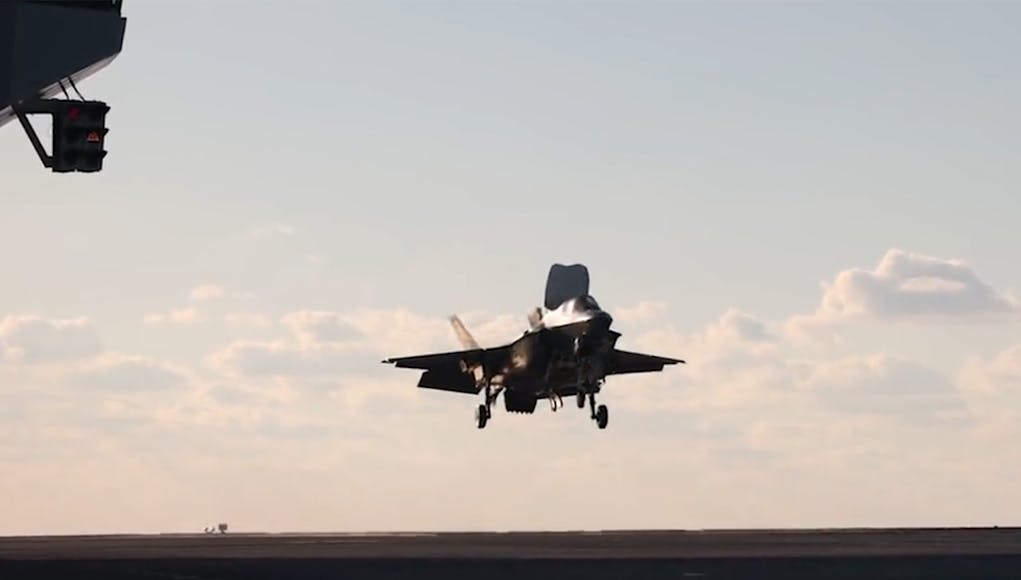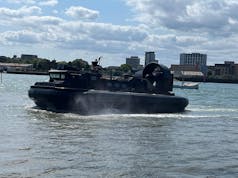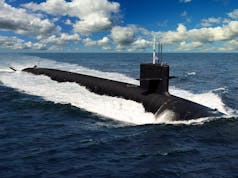HMS Prince of Wales, currently conducting trials off the American coast, has witnessed its first Shipborne Rolling Vertical Landing.
The Shipborne Rolling Vertical Landing (SRVL) is a British endeavour—a capability at least a decade in the making—that will allow pilots to return to ship with more stores on the aircraft after a mission.
It is a process designed to land jump-jet aircraft that uses both the vertical thrust from the jet engine and lift from the wings, thus maximising the payload an aircraft can return with and stopping the financial waste that comes with dropping expensive weaponry in the sea in order to land vertically.
✅Our first SRVL…
Loads more to come… 💣
❓How do you move an aircraft carrier around the ocean?
Find out tomorrow… pic.twitter.com/h5PHao6w1c
— HMS Prince of Wales (@HMSPWLS) October 19, 2023














Beautiful 🇬🇧🇺🇲
Come on 809 👍
In this case come on VX 23.
Correct mon brave 👍. But we need 809 sqdn up front now! FlyNavy. 👍👌😊
Wasnt the first time its been done , as the Harrier could do it in testing, including once on the De Gaulle
https://www.youtube.com/watch?v=d9A5np4HWmg
This shows both actual and some computer simulations of deck landing
They used a 2 seat old harrier with the short wings with the back seat filled up with the electronics. It did have a special name but can’t remember it now, possibly VAAC. It was a T4 harrier I think. I forget if it was a sea harrier trainer or normal harrier.
Good stuff. Everydays a school day as today I learned the F35b has 6 underwing pylons. For some reason I thought it was only 4.
Once the parameters are worked out of how the aircraft performs in these tests that should give the data to allow it to become a standard operating procedure.
Hopefully it’s as simple as uploading the data to all the aircraft and all the pilot has to do is hit the land button.
Amazing how much this aircraft has improved over the harrier in ease of vertical flight.
When compared to arrested landings this seems so uneventful. If the B had the same wingspan as the C it could perform the maneuver with less thrust from the lift fan which would then mean smaller lift fan could be fitted = more payload/range.
I like this idea. If this becomes standard practice then there is no need for a vertical component, just an assisted takeoff and slow rolling landing needed.
A big wing F35B.
That made me think, surely a slow stall speed landing and a short high lift takeoff being the norm on the QE class could lead to a different drone concept for supply, AEW, etc.
I am thinking of a high lift, low stall speed winged autogyro concept. Like a Gyrodyne or Heliplane – but with the rotor never being powered. As it never needs to land or take off vertically – the unpowered rotor is only there to provide extra lift at slow speed for takeoff and rolling landing. The wing provides the lift when it’s actually flying.
A larger wing would add weight & drag throughout the flight regime for a tiny improvement on landing. Terrible trade off.
If you want greater range for the F-35B just add drop tanks.
Unfortunately that negates the stealth technology as does anything else mounted externally. If they do actually fit the QE’s with the limited Cats and Traps they are looking at then thatvooens up a whole new Ball Game. We could operate the Boeing MQ-25 Stingray Tanker drone, which is the way the USN is going They see it as an optimum solution to their range issues and they don’t have to use up F18 flying hours just for buddy tanking duties.
Stealthy drop tanks are being developed for the F-22, and could be developed for the F-35.
Nice to see that you still don’t actually read what is written but at least you are consistent. I said “limited cats and traps” in Feb 2021 the MOD issued an rfi for a system to handle a maximum launch weight of 55,000lbs (24,949 kgs) or 25 tonnes to you.
Which isn’t enough for a conventional manned aircraft but perfectly suited to fully loaded MQ-25 or other medium weight drones such as the Vixen UAV. As for the funding that is a Political decision but the QE’s were designed for incremental improvements / additions from the start.
The F35C model has a bigger span wing, wider flaps and horizontal tail surfaces and has a longer range too.
The reason is aerodynamics and the longer wing span- about 4ft each side from memory- the extra weight is offset by the reduced drag from lift that the wider span allows
Assume now there’s a dangerous word ! Far from being a dead end the RFI is all part of the FMAF programme. Part of that is Project Ark Royal which is a well thought out project to investigate, trial and implement UAV as part of the future QE airgroup.
That project incorporates scoping what sort of UAV we need and his to operate them, in fact Prince of Wales will conducting trials of the GA Mojave drone very shortly whilst she is over the pond.
It’s not a dead end, in fact it is the only logical, cost effective way we can develop the future requirements. UAV will replace the current generation of Carrier AEW, Aerial refuelling, Recce, MR and probably ASW.
Personally I can’t ever see the RN going full on CATOBAR, but reconfiguring them for an angled deck with light/medium weight Cats & Traps is a far more affordable package.
Just Google Project Ark Royal.
F35C has 43ft wing span compared to A and B’s 35ft. This gives better low-speed handling qualities for the carrier approaches. The offset is more drag. Of the 3 varients, the F35C is the slowest to accelerate to its advertised top speed of M1.6. The true top speed will be classified.
Which causes more drag. The F35C has excellent lower speed handling qualities because of the larger wing, and horizontal stabilisers. The offset is slightly poorer supersonic performance. That is basic aerodynamics. The F18 also suffers the same supersonic drawbacks compared to a F16 or F15. All F35 varients have the same published top speed. Just the F35C takes the longest to get there.
The F35C has a longer range because it carries more fuel. In the real world there is very little difference between the A and C when it comes to range. F35A is a 9G airframe. F35C is 7.5G. Both have 50 degrees AoA limit. The F35C has a slightly better Instantaneous turn rate because of the larger wing, but the worse sustained turn rate of the 3 varients, because of the extra drag from the big wing. F35A also regains energy quicker because it has less drag (smaller wing) The F35C also has the slowest acceleration figures of the three varients because….you guessed it, it has more drag and weight. The F35A and B have a landing speed of 155 knots, and F35C is 135knots.( ideal fir carrier landings) If the larger wing reduced drag, and thus increased performance, all 3 varients would have the larger wing. But they don’t, because it brings disadvantages if you are not landing on aircraft carriers. (CATOBAR) F35A handles like a F16 with the AoA capability of an F18. F35C handles more like a super Hornet.
Adding any cross section will add drag but adding wing area generally increases lift which means you need less power to get the same lift. Lift will trump yge drzg. The B biggest drawback is the lift fan. Reduce that dead weight ie the lift fan, which is only used for take off and land you get better performance.
But it would still need the same power to hover. 👍 I get what you mean though.
I would say why hover. If you nail sbrvl. Vertical take off and landing is only performed when you really have to. Even F35b deployed to austere locations would rather use stol than vtol if conditions allowed. Those conditions are a relatively short strip of tarmac or. concrete.
I think SRVL will be used a lot, but not as the norm. SRVL requires a clear flight deck, with helicopters clear of the spots. Vertical landing gives you more flexibility where you can place other aircraft between take-off and landings. Plus, the pilot’s have to remain current with Vertical landings. But you are right, even during the Harrier days at RAF Cottesmore, SRVL style landings were very common.
The F35 range are so A B and C are very different aircraft with a commonality of some parts.
Yes. I understand it would actually require a 4th type a D version. But it’s a version that could make the B redundant.
Never going to happen I would venture. Cost being the obvious limiting factor. Then who would be the volume customers. Take out the USMC orders for the current B variant, that leaves a thin order book.
To give a case comparison look at the cobra / apache history. There was a move to a similar commonality with helos in the US. Given the cobras huey roots. Along came the very capable apache and black hawk. The USMC looked lovingly at the apache. Hoping the commonality approach would help with funding. However after talks with the manufacturer it quickly became apparent the costs would not add up. The apache would need different engines, blades, airframe, and undercarriage. Mainly due to two factors hostile sea environmental conditions and deck landings. Essentially it would be a different aircraft. The USMC knew congress would not pass the funds easily. The upgrades for the cobra were coming to fruition and that was seen as the better and more achievable option.
The above is the explanation I got from a cobra when I was with the 26 MEU. It was an answer to my question “would they prefer the apache”
The sort answer was “That dog won’t hunt”
Then they explained the politics and practicalities.
I think the D you ask for would suffer a similar fate. The USMC are wedded to the B and will not be asking for yet another variant. Upgrades to the B yes.
The F35B was designed for the USMC. As such it’s dimensions were dictated by the lifts and hangars on US Navy assault ships.
And yet those same ships operate the osprey. The F35c wings fold to reduce its deck and hanger space for this very reason
So they are using a USMC F35B for the trials, why ? I know we don’t have many but we are supposed to have 3 earlier ones permanently Stateside for trials !
Because they have modern instrumentation. If I recall correctly only two of the three UK test and dev aircraft are fully wired and instrumented, and they were built in 2011/12. Zero chance that they have been kept up to date at considerable cost. The VX-23 aircraft are only slightly younger, but almost certainly have been heavily upgraded over the years. Note that many personnel from 207 TES squadron have embarked on PWLS, and they will be familiar with the American aircraft.
I must say, the f35’s on P of W look awesome in beast mode
I wonder how the Shipboard Rolling Landing would impact the heat issues that the Japanese Izumo Class and the American Wasp Class “light carriers” were having with the F-35B burning the deck in the landing area. If you are approaching at 5 to 10 knots while descending you will not be inflicting the deck with 15 to 20 seconds of intense heat on the deck as has been seen with the side approach, just 5 or 6 seconds as the B arrives from astern and moves forward at a steady rate.
I wonder if this would not only allow the Japanese and USMC pilots to return with more ordnance and fuel but to allow the ship design teams to require slightly less in the way of temperature proof designs for the landing area, which may in turn allow the B’s to operate from more LHD classes.
I hope the Royal Australia Air Force in a very short space of time reconsiders and purchases at least 12 of the F35-B as we have x2 ships now that they can be used on.
Still no sign of Dauntless joining up with PWLS for WESTLANT23 – which is now entering its third and probably final month. As far as I can make put, the USN/MSC has generously provided her with escorts and replenishment ships for almost the entire deployment. YouTube videos frequently show an Arleigh Burke destroyer in company, and the carrier refuelling from MSC “oilers”. PWLS has done a few small favours in return, e.g. helping to carrier qualify USMC pilots, but overall it’s a bit embarrassing for the RN.
When will these carriers embark with double the number of F35’s they sail with now?
They need to be fully trained up to deal with 16 or more in a conflict situation. 8 will not cut it.